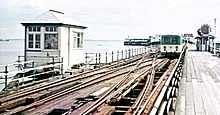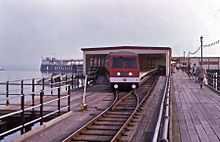Southend Pier Railway

The Southend Pier Railway is a narrow gauge railway in the English seaside resort of Southend-on-Sea. It runs the 1.34 miles (2.16 km) length of Southend Pier, providing public passenger transport from the shore to the pier head.
Operation
| Southend Pier Railway (1986-) route diagram | |||||||||||||||||||||||||||||||||||||||||||||||||||||||||||||||||||||||||||||||||||||||||||||||||||||||||||||||||||||||||||||||||||||||
|---|---|---|---|---|---|---|---|---|---|---|---|---|---|---|---|---|---|---|---|---|---|---|---|---|---|---|---|---|---|---|---|---|---|---|---|---|---|---|---|---|---|---|---|---|---|---|---|---|---|---|---|---|---|---|---|---|---|---|---|---|---|---|---|---|---|---|---|---|---|---|---|---|---|---|---|---|---|---|---|---|---|---|---|---|---|---|---|---|---|---|---|---|---|---|---|---|---|---|---|---|---|---|---|---|---|---|---|---|---|---|---|---|---|---|---|---|---|---|---|---|---|---|---|---|---|---|---|---|---|---|---|---|---|---|---|
| |||||||||||||||||||||||||||||||||||||||||||||||||||||||||||||||||||||||||||||||||||||||||||||||||||||||||||||||||||||||||||||||||||||||
The line is owned and operated by Southend-on-Sea Borough Council, and operates every day the pier is open. The normal service uses a single train, and runs every half-hour. At peak times a two train service is operated, providing a 15-minute interval service. Trains operate between stations known as Shore and Pier Head with no intermediate stops.[1]
Although once electrified, train service is currently provided by two diesel trains, running on 3 ft (914 mm) narrow gauge track. Each train consists of a diesel-hydraulic locomotive at the southern end, five trailer coaches and at the northern end, a driver control unit with passenger space. One train is named Sir John Betjeman, and the other Sir William Heygate.[2]
A twin track island platform is provided at each terminus, and there is a passing loop in mid-pier, otherwise the line is single tracked. The pier head terminus is in the open air, but the shore terminus is enclosed, and also provides rail access to a workshop for maintaining the trains. The Southend Pier Museum is situated below the shore station.[2]
History
| Southend Pier Railway (1930-1978) route diagram | |||||||||||||||||||||||||||||||||||||||||||||||||||||||||||||||||||||||||||||||||||||||||||||||||||||||||||||||||||||||||||||||||||||||
|---|---|---|---|---|---|---|---|---|---|---|---|---|---|---|---|---|---|---|---|---|---|---|---|---|---|---|---|---|---|---|---|---|---|---|---|---|---|---|---|---|---|---|---|---|---|---|---|---|---|---|---|---|---|---|---|---|---|---|---|---|---|---|---|---|---|---|---|---|---|---|---|---|---|---|---|---|---|---|---|---|---|---|---|---|---|---|---|---|---|---|---|---|---|---|---|---|---|---|---|---|---|---|---|---|---|---|---|---|---|---|---|---|---|---|---|---|---|---|---|---|---|---|---|---|---|---|---|---|---|---|---|---|---|---|---|
| |||||||||||||||||||||||||||||||||||||||||||||||||||||||||||||||||||||||||||||||||||||||||||||||||||||||||||||||||||||||||||||||||||||||
The current Southend Pier was preceded by a wooden pier built in 1830. In 1851, a narrow gauge horse tramway was introduced to convey goods and visitors to the pier head.[2][3]
Construction of the current pier commenced in 1887, and the plans included provision for an electric railway. Construction of the line commenced in 1888, with electrification being carried out by Colonel R. E. B. Crompton. By 1890, 0.75 miles (1.21 km) of 3 ft 6 in (1,067 mm) gauge single track had been laid, and a single toastrack style car was in use. By the following year the line ran the then full pier length of 1.25 miles (2.01 km) and trailer cars were in use. The system expanded, until eventually, by 1930, four trains, each made up of seven cars, were running on a line that was double track throughout.[2]
In 1949 the rolling stock was replaced with new trains similar in design to London Underground stock, built by AC Cars, of Thames Ditton, in Surrey. The new stock comprised four trains, again of seven cars, and was liveried in green and cream. Each train could carry up to 260 passengers. At a top speed of 18 mph, the journey took four minutes each way, and during peak periods a train ran every five minutes, continuing until 11pm. The record for passengers carried in one day stands at 55,000.[2][4]
In 1950, two redundant 1899 built trailer cars were acquired by Volk's Electric Railway in Brighton, where they were converted into motor cars numbered 8 and 9. These cars continued to operate in Brighton until the late 1990s, when they were again retired. Car 8 was returned to Southend to join the Southend Pier Museum collection, and car 9 is on display at the South Downs Heritage Centre at Hassocks.[5]

In 1978 the electric railway closed, due to deterioration and the cost of repairs. The 1949 built electric cars were withdrawn, although preserved examples can be found in the Southend Pier Museum and the Lynn Tait Gallery in Leigh-on-Sea.[2][6]

The railway was reopened by Princess Anne on 2 May 1986 after rebuilding to 3 ft (914 mm) gauge.[7] Two new diesel trains were built by Severn Lamb and introduced on a simplified line comprising a single track with a passing loop and twin track terminal stations. As originally delivered, the trains were liveried in all-over burgundy with a white waist-band, but were repainted to a two-tone blue in 2006, retaining the white waist band. They also carry a "Southend Borough Council" logo.[2]
A battery powered single passenger car, built by Castleline of Nottingham, entered service in November 1995 for service in winter. This car is numbered 1835, the year that Southend Pier first appeared on Admiralty charts.[3] There are also several wagons for maintenance trains.
On 9 October 2005, a fire severely damaged much of the pier head including the railway station. The station was temporarily re-sited, until a new and modern structure was opened on the original site in September 2009.[8][9] Although the passenger trains were not damaged, two wagons used on maintenance trains were destroyed in the fire.
The railway in popular culture
- Celtic folk band Straight Furrow were inspired by the railway to write an instrumental, "The Old Pier Railway" MP3 sample
Gallery
-
One of the 1949 trains mid-pier, heading shorewards in October 1975. Just behind the train, one of the line's two signalboxes is visible, jutting out over the sea.
-
Entrance to pier and shore station. The station is to the left at street level whilst pedestrian access to the pier is at the upper level over the station roof.
-
The shore station looking south, with both trains present.
-

'Sir William Heygate' emerging from the shore terminus in 2008.
See also
References
- ↑ "Opening Hours, Ticket Prices and Pier Train Information". www.southend.gov.uk. Southend-on-Sea Borough Council. Retrieved 19 August 2010.
- ↑ 2.0 2.1 2.2 2.3 2.4 2.5 2.6 "Transport Miscellany article on the Southend Pier Railway". Greywall Productions. Retrieved 19 August 2010.
- ↑ 3.0 3.1 Piermaster (16 October 2009). "Southend-on-Sea". Jelsoft Enterprises Ltd. Retrieved 20 August 2010.
- ↑ South East Echo (retrieved 23 2010)
- ↑ "The ex-Southend Cars 8 & 9". Volk's Electric Railway Association. Retrieved 20 August 2010.
- ↑ "Southend Pier History". The South East Echo. Retrieved 25 August 2010.
- ↑ Railway Magazine (September 1986 p551)
- ↑ "Pier to cost millions to restore". www.bbc.co.uk (BBC). 10 October 2005. Retrieved 20 August 2010.
- ↑ "Southend Pier restoration and new train station by Saville Jones Architects". Architect's Journal. Retrieved 19 August 2010.
External references
| Wikimedia Commons has media related to Southend Pier railway. |
Coordinates: 51°31′33″N 0°43′03″E / 51.525731°N 0.717461°E


